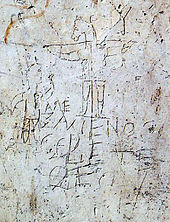


Onolatry is the supposed worship of the donkey. In Imperial Rome, the charge of onolatry was used to taunt the Jews and early Christians.[1] The association of Jews with donkeys was a common feature of Hellenic as well as Latin ethnographic and historical writings, and included accusations of worshipping a golden donkey head and even sacrificing foreigners to it at intervals.[2] A famous example of this is the Alexamenos graffito.[3]
The charge was likely first used against Jews in Egypt, where donkeys were at some points associated with Set, the murderer of Osiris who is in turn destroyed by Isis.[4] It is first attested in the late first century BCE, and was used against Christians extensively in the first and second centuries CE before disappearing almost entirely in the third.[5] The accusation against the Christians is discussed by Tertullian and Minucius Felix, among other early Christian apologists.[6]
Arthur Bernard Cook, in an 1894 article, argued that there had been an ancient Mycenaean cult practising onolatry, citing a fresco depicting donkey-headed figures found near a sacrificial pit and several carved gems apparently showing people wearing donkeys' heads and skins holding sacrificial objects, and further describing the diverse roles asses played in Ancient Greek mythology.[7] His interpretation was challenged at the time by Andrew LanginLongman's Magazine.[8]
|
| |
|---|---|
| Breeds by region |
|
| Events |
|
| Products |
|
| Culture |
|
| |